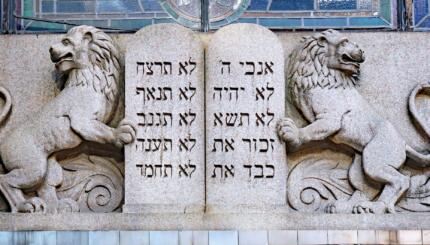During the Six Day War of June 1967, Israeli forces took the Sinai, the Gaza Strip, Jerusalem, the West Bank (often referred to as Judea and Samaria), and the Golan Heights. Although these “territories,” with the exception of Jerusalem and the Golan Heights, were never incorporated into the state of Israel, [and Israel eventually withdrew from the Gaza Strip in 2005] the question of their future has been a central topic in Israeli politics and is at present perhaps the most important issue dividing the major political parties.
Israeli policy regarding the territories has been influenced by diplomatic, security, economic, religious, and moral considerations, and interpreted and prioritized differently by different political leaders and parties. Many observers see the issue of the territories as the key to a resolution of the Arab‑Israeli conflict, and the peace process [when it has been active] indeed has focused on the transfer of power over increasing areas of the territories to a Palestinian Administration. It is therefore important to note at the outset that the Israeli occupation of the territories was a result, and not the cause, of the conflict between Israel and its Arab neighbors.
Origins
Before 1967, the territories were administered by Syria, Egypt, and Jordan. The Golan Heights were an internationally recognized part of Syria even before the latter’s independence after the Second World War. The Sinai came under British‑Egyptian rule back in 1906. The Gaza Strip and the West Bank/Judea‑Samaria were part of the territory defined by the United Nations in 1947 as a Palestinian Arab State.
After the Arab defeat in 1948, Egypt put the Gaza Strip under a military government, and Trans‑Jordan in 1950 annexed the area it held west of the Jordan River, which became known as the West Bank. This annexation was recognized neither in the Arab world nor in the international community. Trans‑Jordan then changed its name to Jordan.
With your help, My Jewish Learning can provide endless opportunities for learning, connection and discovery.
The city of Jerusalem, which was to have been internationalized according to the United Nations plan, was divided between Israel and Jordan along the cease‑fire lines. [Jewish access to holy places in the old city of Jerusalem between 1949 and 1967 was denied.] This situation continued essentially unchanged until June 1967.
The Six Day War
While a detailed analysis of the developments leading up to the Six Day War lies beyond the scope of this [article], several key facts should be noted. The concentration of Arab forces near Israeli borders, the Egyptian expulsion of the United Nations peace‑keeping troops from Gaza and the Sinai, the closure of the Straits of Tiran (blockading the Israeli port of Eilat), and the formation of a military pact by the surrounding Arab states prompted Israel in May 1967 to seek a diplomatic solution to the crisis.
When this was not forthcoming, the Israeli government debated whether to take pre‑emptive military action, or to wait for the first blow of an Arab attack, which would exact a greater price in Israeli lives. The government decided on the former option.
After a surprise air attack on June 5–which destroyed the Arab air forces–Israel decided upon its main objective: the Sinai and the Egyptian positions, which commanded the Straits of Tiran. Jordan was notified that if it abstained from fighting, Israel would refrain from any further action against it. When Jordan entered the war, Israeli forces responded and took the West Bank and East Jerusalem in the ensuing battles. During the last two days of the war, the Israeli army conquered the Golan Heights, from which the Syrians had sniped and shelled Israel settlements below.
By the end of the fighting on June 10, Israel was in possession of the Sinai, the Gaza Strip, Jerusalem, the West Bank, and the Golan Heights. These areas were given various designations [by different people], most of which reveal a political view: the liberated territories, the administered territories, the occupied territories, or the conquered territories. The areas which had been ruled by Jordan were either referred to as “Judea and Samaria”–in order to emphasize the historical Jewish link with the region–or continued to be known as the “West Bank,” suggesting a connection with Jordan or a semi‑independent status.
Initial Policies
Israeli policy after the war distinguished between the Sinai and the Golan Heights, which had been recognized possessions of Egypt and Syria respectively, and other areas in which there was no recognized ruler and which were strategically and ideologically important to Israel.
On June 27, East Jerusalem–expanded to include Rachel’s Tomb on the outskirts of Bethlehem and the Kalandia airport close to Ramallah–was formally incorporated into the West Jerusalem municipality. Israeli law and administration were extended to these areas. In August, the Israeli national unity government (which at the time included former opposition leader Menachem Begin) made Egypt an offer to withdraw from the Sinai in return for a solution to the problems of the Straits of Tiran, free navigation in the Suez Canal, the demilitarization of the Sinai, and a peace agreement. A similar proposal regarding the Golan was made to Syria in exchange for demilitarization of the Golan, guarantees of water supply from sources of the Jordan River to Israel, and peace.
No specific offers were made regarding the West Bank/Judea‑Samaria or the Gaza Strip, but Israeli leaders did state publicly that new frontiers would be the product of direct negotiations with the Arab countries concerned.
The Response
The Arab response was formulated at the Arab League summit held in Khartoum, Sudan on September 1, 1967: “…the Arab Heads of State agreed on unifying their efforts in Joint political and diplomatic action at the international level to ensure the withdrawal of Israeli forces from the occupied Arab territory. This is within the framework of the basic Arab commitment, which entails no recognition of Israel, no conciliation or negotiation with her, and the upholding of the rights of the Palestinian people to their land.”
On November 22, the United Nations Security Council passed resolution 242 as a compromise between American‑backed Israeli demands for mutual recognition and direct negotiations leading to border agreements, and the Soviet‑Arab insistence on unconditional Israeli withdrawal as a precondition for any negotiations. The resolution called for “withdrawal of Israel armed forces from territories occupied in the recent conflict” and “acknowledgement of the sovereignty, territorial integrity, and political independence of every state in the area and their right to live in peace within secure and recognized boundaries.” [In the resolution, omission of the definite article “the” before “territories” is understood to mean that in the final settlement Israel will not be expected to withdraw totally to the 1967 border, but that border adjustments will be negotiated.]
A Special Representative was to proceed to the Middle East “to establish and maintain contacts with the states concerned in order to promote agreement and assist efforts to achieve a peaceful and accepted settlement.” The Arab refusal to negotiate with Israel directly, and Israel’s unwillingness to give up its major bargaining card before coming to peace agreements with the Arabs, led to an impasse, and to continued Israeli control of the territories.
Reprinted with permission from The Jewish Agency.



